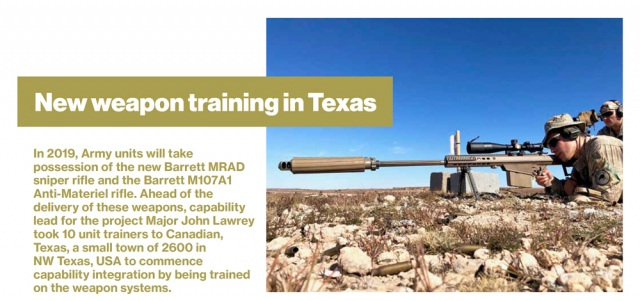
NIOA features in an article of NZ Army News.
---
In 2019, Army units will take possession of the new Barrett MRAD sniper rifle and the Barrett M107A1 Anti-Materiel rifle. Ahead of the delivery of these weapons, capability lead for the project Major John Lawrey took 10 unit trainers to Canadian, Texas, a small town of 2600 in NW Texas, USA to commence capability integration by being trained on the weapon systems.
For the Senior Non-Commissioned and Commissioned Officers attending the two week training programme, this was their first introduction to the weapons and the associated auxiliary equipment such as the Kestrel ballistic computer, Labradar muzzle velocity measuring device, Cruxord weapon tripod and Horus scope reticles.
MAJ Lawrey said the purpose of the trip was to introduce trainers to the new precision weapon systems and identify key differences between the old and new capabilities in order to shape how our Army training modules on weapons needs to shift to meet capability outcomes.
“First up, the manufacturer reps (Barrett, Nightforce, NIOA and CruxOrd) provided basic function and maintenance lessons on the MRAD sniper rifle, M107A1 antimateriel rifle and critical support equipment. We then went to an extremely large training range run by a company called Accuracy 1st who are world leading specialists in military and law enforcement long range precision shooting. It was here where we were taught how to calibrate and shoot the newly procured weapon systems in a range of different situations at distances out to 2000 metres,” said MAJ Lawrey.
“One of the most challenging environments to learn to shoot in is windy conditions. Fortunately, for the NZ Army group Canadian Texas is a pretty windy spot – which is demonstrated by the number of wind turbines in the area.
A number of the group were surprised at the level of mathematical calculations needed to factor in the wind and the added complication of having to do sums in your head quickly without a calculator brought back some memories of high school maths.
“The new sniper and anti-materiel weapons are capable of engaging targets out to 2000 metres, so the group did a lot of long distance shooting training in order to become proficiently accurate – one shot to hit the target. A bullet from the new rifles takes 3–4 seconds to travel 1600m+ to its target, which sounds quick but a lot of environmental factors can come into play over that distance meaning our military precision shooters are always having to think one step ahead of the variables,” said MAJ Lawrey.
One participant Captain Josh Sullivan from Combat School noted “the Accuracy 1st training provided an excellent insight into the capabilities of the M107A1.
Due to the weapon’s simple nature and impressive capability, first time long range shooters like myself were able to produce results that compared to that of the experienced snipers. I’m looking forward to how long range shooting progresses once the AMR is introduced within the RNZIR Fire Support Groups”.
For some of the group this was their first trip to the USA and the locals of Canadian Texas were very hospitable. “On a couple of occasions we had locals pay for our coffee or even lunch and a lot of people were interested in finding out about the NZ Army.
It was common for locals to come up and thank us for our service, whilst it had the same feel as a remote farming community in New Zealand it was a very different but refreshing attitude to the Armed Forces,” said MAJ Lawrey.
To keep things interesting, and to foster some friendly rivalry amongst the group, the Accuracy 1st trainers organised a competition for the last few days. The competition consisted of three challenges: shooting multiple targets in a 360 degree arc; a single shot test on targets out to 1600m; and an 18 hole golf course set-up where the group had to move around and shoot at various steel targets and various unknown ranges. A rep from NZSOF won this competition.
Photo: A soldier fires the Barrett M107A1 anti-materiel rifle.
Photo: The Barrett MRAD sniper rifle with Kestrel ballistic computer.
---

